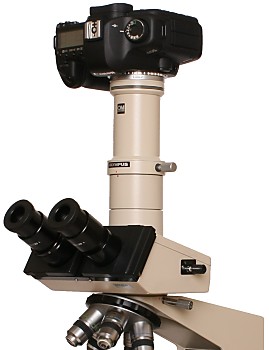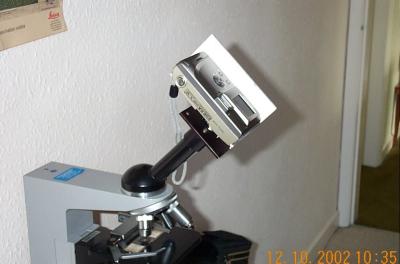Microscopes and digital photography
Digital cameras have made recording photographs through the microscope easy and fun! Previously, taking photographs with a microscope – photomicrography – was challenging, and many years of experience were required to achieve good results. Digital cameras have now made photomicrography accessible to everyone. Almost any digital camera can be used with almost any microscope, although the easiest route to success is using a DSLR with a removable lens, coupled to a vertical photo tube on a microscope and using an eyepiece to project the image directly onto the camera sensor.
 Digital SLR on a trinocular microscope
Digital SLR on a trinocular microscope
Cameras with fixed lenses (compact and bridge cameras) can also be used, although more ingenuity is required to devise couplings to hold the camera lens immediately above the microscope eyepiece.
 Compact camera attached to a microscope
Compact camera attached to a microscope
One potential difficulty with photomicrography is that minor vibrations are ‘magnified’ through the microscope, resulting in images that are out of sharp focus. This can be avoided by using slow shutter speeds, ‘locking up’ the mirror on DSLRs prior to opening the shutter, and by using remote control devices to trigger the shutter. Fortunately, technology is coming to the rescue, and an increasing number of DSLRs allow you to view the image from the sensor (eliminating vibration from raising the mirror) and to start the exposure electronically (eliminating vibration from opening the shutter).
The microscope reveals an amazing world of structures and colours that can be recorded using a digital camera. Free or cheap software can then be used to process or enhance the images to produce stunning results that were not possible in the days of film cameras. One of the most useful techniques for the photomicrographer is image stacking, where the limited depth of field of the microscope is overcome by taking multiple images at different levels of focus, and combining these using cheap software to produce a single image with great depth of field.
 Images (left to right): Proboscis of blowfly (high magnification), Proboscis of blowfly (low magnification), Stomata in cuticle of Araucaria imbricata
Images (left to right): Proboscis of blowfly (high magnification), Proboscis of blowfly (low magnification), Stomata in cuticle of Araucaria imbricata
Many photographers specialise in true macrophotography (images in the range of life size to ×50 magnification) which presents challenges of equipment and technique for those who wish to push their skills to the limits.
Many Quekett members are expert photomicrographers and macrophotographers, and have won international prizes for their work, some of whom use the simplest of equipment and achieve superb results.
Want to learn more?
We have 2 other pages on digital photomicrography:
There are also pages on particular aspects of digital photomicrography, including scale bars, stacking and stitching, in our Resources section.
David Linstead, one of the Club’s most experienced photomicrographers, has produced the following introduction to photography through the microscope. It is formatted as a slide show, so use the arrow keys on your keyboard to go from one slide to the next.

